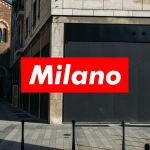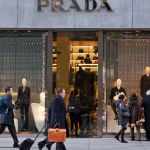
Making sense of Supreme's opening in Milan
The new physical store will set the new creative direction of the brand in the post-hype era
February 18th, 2021
It was February 25th of two years when Supreme presented the lookbook of the SS19 thanks to which the first rumors finally found concrete evidence: the brand was about to open a store in Milan. It was cryptic news, based on a somewhat cerebral clue, in the best style of James Jebbia's brand: in the fabric textures of Metallic Jacquard Crewneck there were the names of the physical locations of Supreme stores among which, in the middle of Paris, London, New York, and Tokyo, Milan also appeared. Today, two years later, after a pandemic, after the change of ownership of Supreme and the end of the legal battle over legit fake, the Milan store is still a pending project even if rumors seem to agree that the location will be in a space of Corso Garibaldi.
VF Corp, Supreme's new owner, seems intent on pursuing the strategy of territorial expansion of physical stores, although many factors have changed. Over the time, lockdown aside, the hype mechanism on which the brand founded its explosive success a few years ago has changed radically, along with the general perception of the brand itself and also the social geography of the city of Milan has changed. But the first Italian opening still makes sense for Supreme and could represent an opportunity to give a new direction to its narrative.
First of all it is important to emphasize the role of the physical store in the mystique of Supreme. At 274 Lafayette Street in the heart of Manhattan in the spring of 1994, James Jebbia hosted skaters, intellectuals, and artists in what was more than a store a squat where casual customers/consumers were not typically welcome. Yet the aesthetic was not that of a classic neighborhood skate store with stacked clothes and a general disorder: the products were folded and arranged almost maniacally, the gadgets aligned perfectly on the shelves, the skate boards occupied the walls and televisions broadcast music or skate videos in the windows. In short, the approach was similar to that of an art gallery where those who entered felt not so much awe as an immediate respect for that aspect, intangible yet perceptible, of extreme cultural curation that emerged from the precise exhibition of the products. It is precisely this immaterial aspect that has created a magnetic imagery, which has subjugated three different generations of skaters and shaped Supreme's aesthetic.
Fast forward to the present day. Supreme's store - be it London, New York, Paris or Osaka - has maintained that sacral aura, but has changed its function: from a creative space to a para-religious place, from a forge of a culture in-the-making to a sanctuary where you could touch the heritage with your own hands. Loyal fans of the brand gathered from week to week in crowded camp out for nights or whole afternoons - moments in which friendships were born, resell business was concluded, the drops and the culture surrounding the brand were commented on and grew in a different way: with the history of the brand already fixed and established (New York, the 90s , the scene of artists and skaters), its myth began to take shape, a myth created around Supreme and made up of Instagram posts, groups of resells and fake box logos. In this sense, crossing the threshold of the store after spending hours in line and having the privilege of buying a brand new product, with its set of labels, bags and stickers, having to deal directly with the clerks assumed the form of a ritual for fans, a meeting with a mythological dimension, which reflected that idea of exclusivity on which Supreme built its business model and implied, if not for the journey to the city at least for rows and waits, a real pilgrimage.
Today, however, Covid-19 has drastically accelerated some changes in the fashion industry that Supreme must take into account: the decline of hype (understood as logomania, resell, camp out and so on), the return of minimalism and a fashion that lives more on values than aesthetics. Supreme has always been extremely resilient and adaptable to external changes in the market and taste while remaining faithful to the taste of Jebbia and the first products designed for skaters. Today the role of the physical store is a question mark for the entire fashion industry, but especially for the American brand it can be the passport to enter a new phase of development and growth by storing up the era of hype, which founder James Jebbia himself did not appreciate too much. According to experts and observers, the future of physical retail will have more to do with the experiential sphere than buying. The role of ecommerce will play an increasing role in the coming years, but physical retail will still remain a key asset to hit the consumer and communicate product values. The Milan store (which from the photos seems ready for opening, support for the sign has already been mounted) can be an opportunity to confirm itself one step ahead of the rest of the industry. The ideas are many: given the size of the space in Corso Garibaldi (about 450 square meters), Supreme could relaunch the format of the concept stores à la Fiorucci, where more than the products the focus is a cross-sectoral aesthetic of the brand. Likewise, the store can host a skate track becoming a skater aggregation place in the posh heart of Milan, between Brera and Moscova. Different strategies, different targets and different objectives.
The event, in short, will be a moment full of opportunities and the opening will also be the first of the new ownership of VF Corp so it will hardly be ordinary administration. Rather, it will indicate the direction that the brand will take in the coming years starting from the target audience. We stand by and watch with the hope of returning to look at a red Box Logo with the same dreamy eyes as ten years ago.

































































































